|
|
Medmaterials in Materdicine
CHEN Yu
2022 Vol. 37 (11): 1149–1150
 Abstract
Abstract(
509 )
 HTML
HTML(
327)
 PDF
PDF(200KB)(
496
)
With the rapid development of the economy and society, the requirements of human beings for disease prevention, diagnosis, treatment, and prognosis are increasing day by day. In particular, the outbreak of the COVID-19 pandemic worldwide has posed a huge threat to human life and health, as well as an extreme impact on the global economy and society. The prosperity of biomaterials and nanotechnology, including but not limited to a variety of micro-/nano-scale biomaterials and a large number of three-dimensional bulk biomaterials, provides new directions and possibilities for solving medical health problems. However, the process with respect to the clinical translation of biomaterials is relatively slow, and currently, only a few biomaterial-based products have received clinical approval. Benefiting from the advances of materials science and clinical medicine, the interdisciplinary integration of these two disciplines, termed materdicine, starts from the issues and challenges in clinic, rationally designs and synthesizes biomaterials/medmaterials with direct application purposes/needs in order to further effectively address the critical problems in clinical practice. Therefore, materdicine chiefly focuses on clinical medicine issues, satisfies the medical requirements through the corresponding biomaterial-involved platforms and technologies, and further extends to medmaterials that are directly related to clinical medicine including materials systems for medical devices. On the one hand, materdicine concentrates on handling the problems faced by traditional medicine, such as low bioavailability, unsatisfactory therapeutic outcome, poor targeting specificity, and systemic side effects. On the other hand, inorganic, organic, and inorganic/organic hybrid medmaterials own unique physicochemical properties at the micro-/nano-scale and can be developed into multifunctional systems for biomedical imaging and disease therapy. More importantly, theranostics in the field of materdicine elaborately combines diagnostic imaging and therapeutic medicine as complementary technologies to implement imaging-guided treatment and monitoring. Other medical technologies and medmaterials based on the development of materdicine, for instance, tissue engineering materials, biosensing materials, and antibacterial materials, also exhibit considerable potential. Although materdicine has experienced explosive growth in every branch and offered substantial opportunities for disease diagnosis and treatment more securely and effectively, its clinical translation still faces several key challenges, such as the controlled synthesis, large-scale production and toxicity evaluation of medmaterials, in vivo biological barriers, integration of diagnosis and treatment, and clinical translation. In recent years, Chinese researchers have done a myriad of representative works in the field of rational design and construction, surface functional engineering, optimization and mechanism exploration of physicochemical properties, and biomedical applications of materdicine and medmaterials. To showcase the state-of-the-art research achievements of Chinese scientists in the field of materdicine and stimulate the interest of all walks of life in materdicine and medmaterial, the Editorial Board of the Journal of Inorganic Materials herein invited Prof. CHEN Yu from Shanghai University as guest editor to compile this Special Issue themed “Medmaterials”. This issue contains the latest reviews and research papers related to medical materials, including piezoelectric semiconductor nanomaterials, group VA single- element two-dimensional materials, bioactive ceramics, metal alloys, and silica-based micelles. It is hoped that this special issue will promote the cooperation of researchers and scientists from many fields with different disciplinary backgrounds, and jointly promote the development of the field of materdicine and medmaterial, so as to revolutionize the diagnosis and treatment of various diseases in clinical medicine for the benefit of human health.
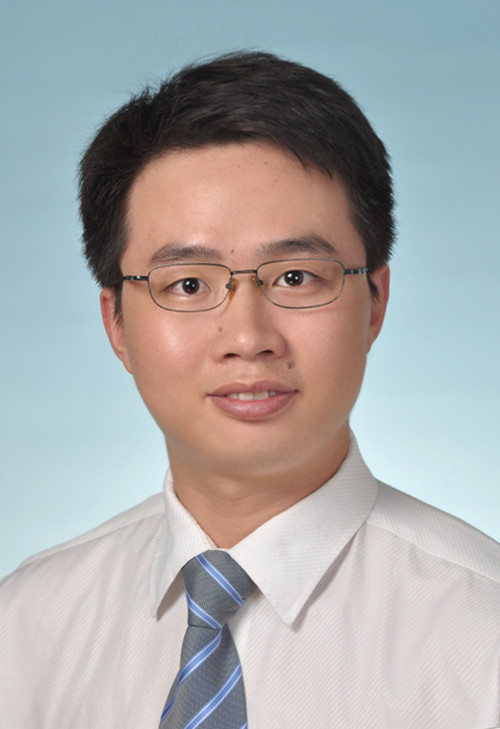
|
|
|
Materdicine and Medmaterial
HUANG Hui, CHEN Yu
2022 Vol. 37 (11): 1151–1169
 Abstract
Abstract(
882 )
 HTML
HTML(
353)
 PDF
PDF(23289KB)(
1108
)
The robust development of clinical medicine and biomaterials boosts diagnostic imaging, effective treatment, and precise theranostics in various diseases. The emerging interdiscipline of materials and medicine, termed as materdicine, aims to surmount the critical obstacles and challenges faced by traditional medicine, such as systemic toxicity, poor bioavailability, inferior site-targeting specificity, and unsatisfied diagnostic/therapeutic efficacy. Herein, the state-of-the-art advances regarding the applications of diverse medmaterials for disease diagnosis, therapy, and theranostics are systematically summarized in this review, especially focusing on the nanoscale medmaterials. We firstly emphasize and discuss biomedical imaging (e.g., optical imaging, magnetic resonance imaging, ultrasound imaging, computed tomography imaging) and therapeutic strategies (e.g., photothermal therapy, dynamic therapy, immunotherapy, synergistic therapy) in the field of cancer treatment. Furthermore, we highlight the important progress of medmaterials in the diagnosis and treatment of other kinds of diseases including orthopedic diseases, respiratory system, and brain diseases. Especially, the elaborated medmaterials for other representative biomedical applications, such as biosensing and antibacteria, are illustrated in detail. Finally, we discuss the current challenges and future opportunities for the practical application of these unique medmaterials in materdicine for accelerating their early realization of clinical translations, promoting the progresses of clinical medicine and benefiting the patients.
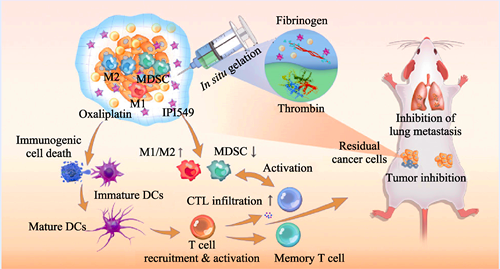
|
|
|
Piezoelectric Semiconductor Nanomaterials in Sonodynamic Therapy: a Review
HUANG Tian, ZHAO Yunchao, LI Linlin
2022 Vol. 37 (11): 1170–1180
 Abstract
Abstract(
874 )
 HTML
HTML(
73)
 PDF
PDF(20537KB)(
970
)
With the development of nanomedicine, utilization of nanomaterials to catalyze the generation of excess reactive oxygen species (ROS) under exogenous ultrasound stimulation has attracted widespread attention for disease therapy, which is called sonodynamic therapy (SDT). Currently, development of high-efficiency sonosensitizers that can be used in SDT to improve ROS yield remains one of the most important challenges for current research and future clinical translation. Recently, benefited from the development of piezotronics and piezophototronics, novel sonosensitizers based on piezoelectric semiconductor nanomaterials have shown promising applications in SDT. In this review, we outline the structures and properties of piezoelectric semiconductors, and introduce the presumed mechanism of SDT with piezoelectric semiconductors. The newest research progresses on using piezoelectric semiconductor as sonosensitizer in cancer treatments and antibacterial applications are summarized. Finally, the existing challenges and future development trends in this field are proposed.
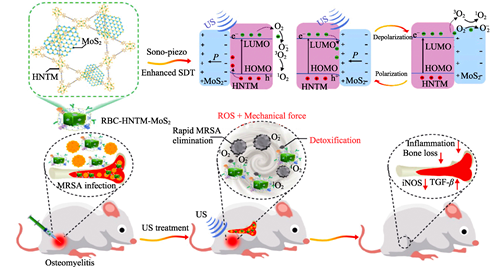
|
|
|
2D Nanomaterials from Group VA Single-element: Research Progress in Biomedical Fields
LEI Weiyan, WANG Yue, WU Shiran, SHI Dongxin, SHEN Yi, LI Fengfeng
2022 Vol. 37 (11): 1181–1191
 Abstract
Abstract(
321 )
 HTML
HTML(
35)
 PDF
PDF(8831KB)(
493
)
With the continuous deepening of research on nanomaterials, it has been applied in a wide range of technical fields, and has great potential to support new discoveries in basic sciences. Among them, nanomaterials composed of single elements are of particular interest because they are tractable and readily available in synthesis. Two-dimensional (2D) nanomaterials from Group VA single-element (including black phosphorus, arsenene) have broad application prospects in biological applications such as bioimaging, drug delivery, and diagnostic therapy due to their excellent physical, chemical, electronic, and optical properties. This review summarizes the general properties, synthesis, and modification methods of group VA single-element 2D nanomaterials, and then focuses on their various biomedical applications. Finally, challenges and future prospects of these nanomaterials in the field of biomedicine are discussed.
|
|
|
Progresses on Hollow Periodic Mesoporous Organosilicas: Preparation and Application in Tumor Therapy
ZHANG Wenjun, ZHAO Xueying, LÜ Jiangwei, QU Youpeng
2022 Vol. 37 (11): 1192–1202
 Abstract
Abstract(
388 )
 HTML
HTML(
32)
 PDF
PDF(3411KB)(
474
)
With the development of mesoporous materials and biomedicine, hollow periodic mesoporous organosilicas (HPMOs), as a new type of mesoporous silicon material, stands out among many mesoporous materials because of its high specific surface area, high drug loading, good biocompatibility, multifunctional organic-inorganic hybrid framework, low cytotoxicity and biodegradability. Drug delivery systems based on HPMOs have been continuously developed, it provides a new strategy for tumor treatment. This article summarized the synthetic progress of HPMOs in recent years, briefly introduced the types of HPMOs, mainly expounded the hard template method, liquid interface assembly method and interface recombination-transformation method, and summarized its application in tumor therapy. Finally, challenges and future development trends as a drug carrier were prospected, in order to provide reference for the preparation and application of HPMOs in tumor therapy.
|
|
|
Copper-incorporated Calcium Silicate Nanorods Composite Hydrogels for Tumor Therapy and Skin Wound Healing
WU Aijun, ZHU Min, ZHU Yufang
2022 Vol. 37 (11): 1203–1216
 Abstract
Abstract(
347 )
 HTML
HTML(
33)
 PDF
PDF(18706KB)(
526
)
Developing a hydrogel with tumor therapy and skin wound healing is of great significance for eliminating residual tumor cells and promoting skin wound healing after surgical resection of skin cancers. Here, copper- incorporated calcium silicate (Cu-CS) nanorods were prepared by a molten salt method with calcium hydrate silicate as matrix, NaCl and KCl as molten salt, and CuSO4·5H2O as Cu source, and then incorporated into sodium alginate (SA) hydrogel to achieve Cu-CS/SA composite hydrogel. The results showed that Cu content of Cu-CS nanorods increased with the increase of the Cu source addition and the treatment temperature, but their catalytic activity for producing hydroxy radical (·OH) from H2O2 exhibited the trend of increasing and then decreasing. Nanorods, prepared with 3% copper source (3Cu-CS) at 700 ℃, displayed the best catalytic performance. Cu with +2 valence state could be uniformly distributed on the surface of Cu-CS nanorods, with Cu content as low as 0.61%. Importantly, Cu-CS/SA hydrogel with Cu-CS nanorods less than 20% were biocompatible and could catalyze H2O2 to produce cytotoxic ·OH in a simulated tumor microenvironment, exhibiting outstanding chemodynamic effect. Furthermore, Cu-CS/SA hydrogel could promote proliferation and migration of human umbilicle vein endothelial cells and human dermal fibroblast. Therefore, Cu-CS/SA hydrogel is a promising material for applying in tumor therapy and skin wound healing.
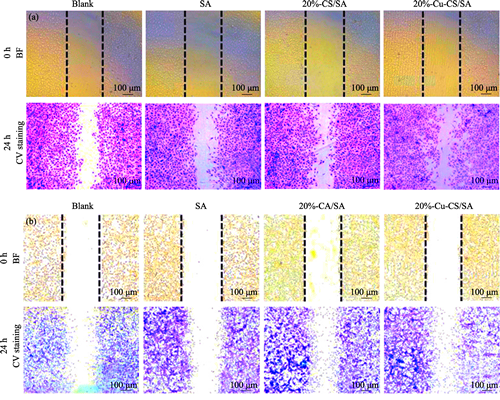
|
|
|
Biological Property Investigation of Nitinol Surface Implanted with Tantalum
WU Ling, TAN Ji, QIAN Shi, GE Naijian, LIU Xuanyong
2022 Vol. 37 (11): 1217–1224
 Abstract
Abstract(
422 )
 HTML
HTML(
27)
 PDF
PDF(10143KB)(
511
)
Nitinol vascular stent can trigger thrombosis and restenosis, but lacks the ability to rehabilitate with injury still to the blood vessel wall. Thus, surface modification to the stent is indispensable for nitinol surfaces to realize biological functions of anticoagulation and accelerate endothelialization. Here, tantalum ions were implanted into nitinol surfaces by plasma immersion ion implantation and deposition (PIII&D). Physicochemical and biological characteristics of the modified nitinol surfaces were analyzed. The results show that the Ta, Ta/Ta2O5, and Ta/Ta2O5-x/Ta2O5-containing modified layers are formed on nitinol surfaces with extension of implantation time. Among all samples, the modified surface containing Ta/Ta2O5-x/Ta2O5 phase possesses better hydrophilicity and provides more sites for cell attachment to promote initial cell adhesion and proliferation. Compared with the solely Ta-bearing surface, the modified surface containing Ta/Ta2O5-x/Ta2O5 shows superior hemocompatibility, on which fewer adhered platelets are observed, maitaining an inactive and original spherical shape. Besides, the hemolysis rates of all samples are far below the threshold value of 5%, indicating that hemolysis hardly happens. The results indicate that Ta ion implantation modified nitinol stent has a potential application in reducing thrombosis and accelerating endothelialization.
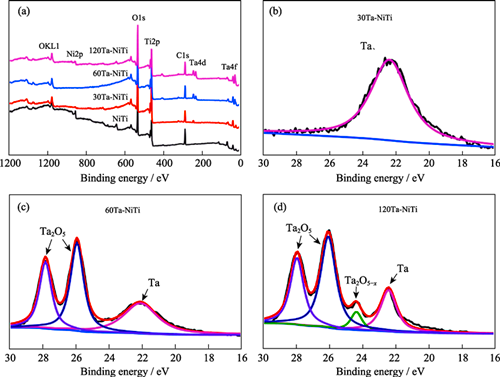
|
|
|
Cobalt-incorporated Chlorapatite: Preparation by Molten Salt Method, Anti-oxidation and Cytocompatibility
SHU Chaoqin, ZHU Min, ZHU Yufang
2022 Vol. 37 (11): 1225–1235
 Abstract
Abstract(
319 )
 HTML
HTML(
29)
 PDF
PDF(9540KB)(
523
)
Orthopedic surgery and postoperative inflammation are easy to induce oxidative stress, which hinders the process of bone repair. Bioactive ceramics have excellent osteogenic properties, but lack the ability to resist oxidative stress. Therefore, it is of great significance to develop a bioactive ceramic material with antioxidant function. Here, cobalt-incorporated chloroapatite (Co-MS-TCP) was prepared by a molten salt method, in which the mixture of lithium chloride and potassium chloride was used as a molten salt system, and β-phase tricalcium phosphate (TCP) and cobalt chloride hexahydrate (CoCl2∙6H2O) were used as raw material and cobalt source, respectively. The antioxidant ability of Co-MS-TCP was determined by catalyzing H2O2 clearance. The cytocompatibility and anti-oxidation of Co-MS-TCP were further evaluated by analyzing the changes of cell viability and intracellular reactive oxygen species (ROS). Results showed that Co-MS-TCP with controllable cobalt content can be prepared by a molten salt method with changing the addition amount of CoCl2∙6H2O source. The scavenging capacity of H2O2 increased with the increase of cobalt content in chlorapatite, and more than 90% of H2O2 could be scavenged within 6 h due to the catalytic activity of Co-MS-TCP. Furthermore, cell experiments confirmed the cytocompatibility and antioxidative property of Co-MS-TCP. 3% Co-MS-TCP at a concentration of 1.5 mg·mL-1 could still ensure the survival rate of bone marrow mesenchymal stem cells and chondrocytes to be higher than 85%, and 3% Co-MS-TCP can also significantly reduce the content of intracellular ROS for the H2O2-stimulated cells. Therefore, molten salt method is an effective way to prepare cobalt-incorporated bioactive ceramics with antioxidative property, which also provides a promising strategy for the development of functional bioactive ceramics with high catalytic activity and biocompatibility.
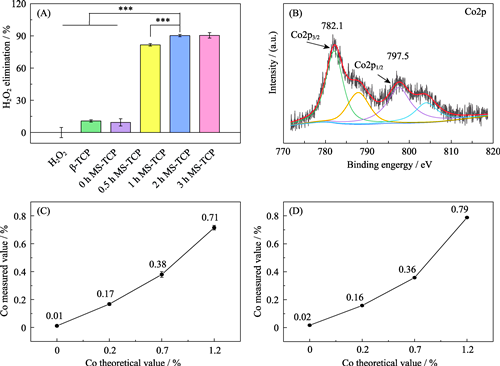
|
|
|
Flav7-loaded Silica-based Hybrid Micelles: Synthesis and Photothermal Performance
CHI Zheren, ZHANG Liao, GUO Zhiqian, LI Yongsheng, NIU Dechao
2022 Vol. 37 (11): 1236–1244
 Abstract
Abstract(
299 )
 HTML
HTML(
20)
 PDF
PDF(13138KB)(
479
)
Recently, organic small molecule photothermal agents have great application potentials in the field of biomedicine due to their high extinction coefficient in the near-infrared region and good structural tunability. Unfortunately, most current organic small molecular photothermal agents prove to be still poor water solubility, unsatisfactory biological stability, and low photothermal conversion efficiency. To address these, a simple method was developed to prepare Flav7-loaded silica-based hybrid micelles (FPOMs) for efficient photothermal therapy. Firstly, the Flav7-loaded micelles were prepared by self-assembly of block copolymer PS132-b-PAA16. Then, 3-mercaptopropyl trimethoxysilane (MPTMS) and polyethylene glycol (PEG) were introduced to fix the structure and endowed the surface modification of the system, respectively, resulting in the final formation of FPOMs. Results show that FPOMs exhibit excellent photothermal stability and high photothermal conversion efficiency (46.7%) under the excitation of 808 nm laser. Cell experiments indicate that FPOMs have good biocompatibility and photothermal toxicity. It is highly expected to be used as a new type of nano-photothermal agent for efficient and safe photothermal therapy.
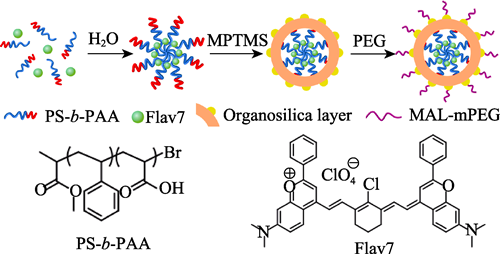
|
|
|
Nd-doped Mesoporous Borosilicate Bioactive Glass-ceramic Bone Cement
CHEN Cheng, DING Jingxin, WANG Hui, WANG Deping
2022 Vol. 37 (11): 1245–1258
 Abstract
Abstract(
474 )
 HTML
HTML(
31)
 PDF
PDF(4437KB)(
658
)
As a common malignant bone tumor, osteosarcoma is usually treated by surgical resection. However, the bone defects caused by surgery are difficult to heal, and the possibility of osteosarcoma recurrence can also be increased by the residual tumor cells. Therefore, a Nd-doped mesoporous borosilicate bioactive glass-ceramic bone cement was developed for repair of bone defects and synergistic therapy of osteosarcoma. Firstly, as photothermal agent and drug carrier, Nd-doped mesoporous borosilicate bioactive glass-ceramic (MBGC-xNd) microspheres were prepared through Sol-Gel method and solid-state reaction. Then MBGC-xNd microspheres were mixed with sodium alginate (SA) solution to prepare injectable bone cement (MBGC-xNd/SA). The results showed that Nd3+ endows microspheres with controllable photothermal properties, and microspheres loaded with doxorubicin (DOX) showed sustained drug release behavior. In addition, the drug release from drug-loaded bone cement was significantly accelerated with the increase of temperature, indicating that the heat generated by photothermal therapy had the possibility of promoting the release of DOX. In vitro cell experiment results showed that MBGC-xNd/SA had good osteogenic activity. Simultaneously, photothermal-chemical combination therapy had a more significant killing effect on MG-63 osteosarcoma cells, indicating a synergistic effect. Therefore, MBGC-xNd/SA, as a novel multifunctional bone repair material, exhibits a potential application in the postoperative treatment of osteosarcoma.
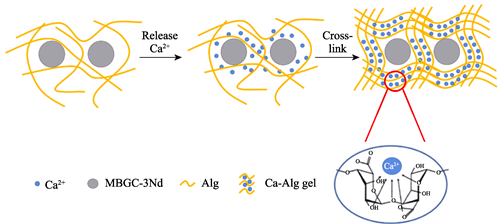
|
|